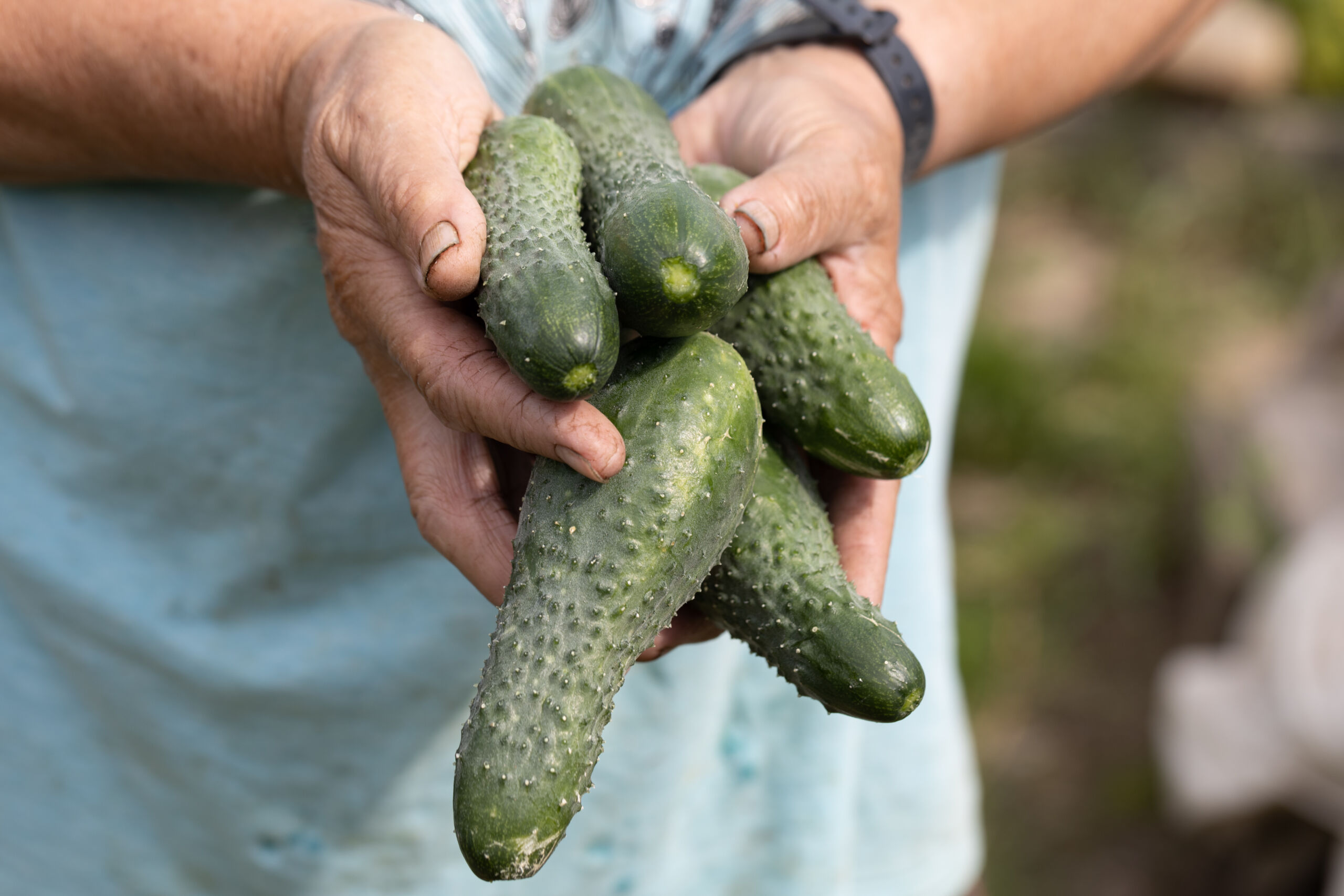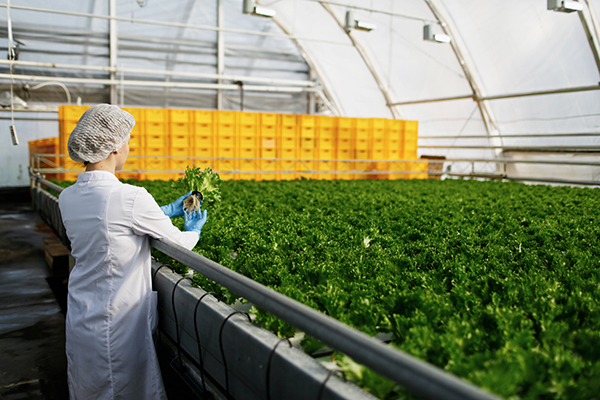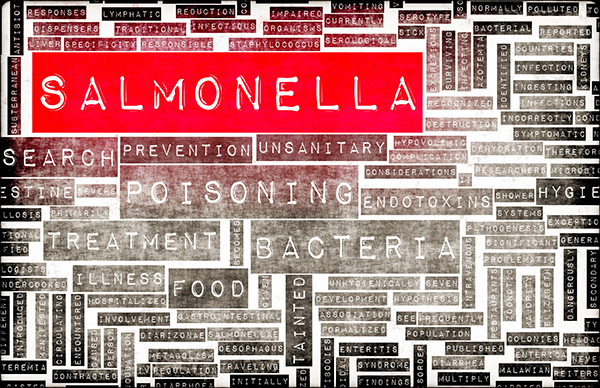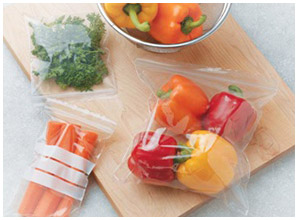The Second Wave: Food Safety Myths That Deserve Your Attention
Walk into any commercial kitchen, and you'll find hardworking staff following protocols they have learned over the years. Many are correct, but others are dangerously wrong. In our last blog, we started exploring these myths, and once I started, I couldn’t stop! Myth #5: Sanitizer Works Instantly Sometimes our staff see sanitizer as a quick fix: spray, wipe, and move on. In a busy kitchen where speed matters, the [...]
What Your Staff Gets Wrong About Food Safety (And How to Fix It)
Earlier this month, I was mindlessly scrolling through Facebook when I came across a post on a gardening blog where someone had frozen their homegrown garlic as a means of preservation. After two months, they pulled the garlic out of the freezer and thought it didn’t seem to be frozen. Because the original poster was aware that garlic had been linked to botulism outbreaks in the past, they inquired [...]
Your Guide to Approved Food Safety Training Programs in 2025
Early in my foodservice career, I persuaded the owners of the restaurants I managed to train all our production employees in food safety. Knowing that the cost, both in terms of training materials and employee hours in training would be substantial, I tried to minimize the cost by becoming a certified instructor of the course I wanted to offer and teaching it to our employees myself. Little did I [...]
Thanksgiving Food Safety: Separating Fact from Fiction
Most blogs that I write are geared toward the foodservice professional preparing food in commercial foodservice operations. This one is no different, but it intentionally straddles the line between home and commercial foodservice. Regardless of whether you are preparing turkey dinners for paying guests or gathering with friends around your own table, the principles of food safety remain the same. Unfortunately, the Thanksgiving holiday also brings with it a [...]
Preventing Norovirus in your Foodservice Operation
Norovirus is one of the leading causes of vomiting and diarrhea in the United States, causing between 19 and 21 million illnesses each year. These illnesses result in over 100,000 hospitalizations. Our foodservice colleagues in certain facets of the industry, such as schools, daycares, healthcare, and cruise ships are particularly susceptible to having to deal with norovirus outbreaks. But norovirus could impact all of us, regardless of how many [...]
Safe Handling of Leftovers in Foodservice Operations
In any foodservice operation, leftovers are inevitable. After managing a family-style restaurant, where all-you-can eat sides were offered to almost every table, and having banquet space in-house, I became well versed in how to handle leftovers. It does not matter if it is uneaten portions from a buffet, prepped ingredients, or food returned from a catered event, proper handling of leftovers is critical to prevent foodborne illness and making [...]
Turn your Health Inspector into your Food Safety Ally
For many foodservice operators, keeping up with evolving regulations can feel like chasing a moving target. According to Datassential’s 2025 Midyear Trends Preview Report, more than half of operators (53%) say new food safety regulations are often difficult to understand and implement. That number reflects a reality most in the industry know well: regulations are essential, but they can be complex, time-consuming, and sometimes confusing. On top of that, [...]
Time and Temperature: Why 41°F to 135°F?
In one of my last blogs, I mentioned the temperature danger zone, or TDZ, as those in foodservice often refer to it. Learning the TDZ is almost a rite of passage for any new employee. Most could recite it in their sleep: “41°F and 135°F, the zone where bacteria multiply quickly.” In the foodservice environment, the TDZ isn’t just a best practice; it’s a critical defense against foodborne illness. [...]
Maintaining Food Safety Standards Amid Seasonal Turnover
Across the country, summer seems to bring on more than just an influx of business in foodservice operations. It also tends to bring an influx and an exodus of employees. As seasoned employees head out for vacations or move on, new hires and seasonal staff fill in, often with minimal experience. This constant churn can create gaps in food safety practices at exactly the time when warm weather increases [...]
When Temperatures Rise, Keep Food Safety Top of Mind
Summer brings a welcome increase in business for many restaurants, catering services, and event venues. It certainly did for the restaurant that I used to manage. With outdoor dining, festivals, weddings, and seasonal traffic, foodservice operations often experience their busiest stretch between Memorial Day and Labor Day. And the warmer weather creates ideal conditions for bacteria to grow quickly. In our restaurant, it was even more of a challenge [...]
Safely Shopping at Farmers’ Markets: A Food Safety Guide for Foodservice Operators and Chefs
Farmers’ markets are an appealing source of fresh, local, and seasonal ingredients for individuals and families across the United States. They also provide an excellent source of products for foodservice operators and chefs. Local farmers’ markets offer the opportunity to build relationships with local growers, reduce food miles, and bring fresh flavors to the plate. However, shopping at farmers' markets for a commercial kitchen involves more than selecting the [...]
Ice Machines, Beverage Dispensers & Other Overlooked Food Safety Hazards
At the end of the spring semester in our campus food production lab, we’re fortunate to have the opportunity to hit pause and reset for the summer and prepare for fall—a luxury many foodservice operations don’t often get. During this time, we can deep clean, shut down equipment, and perform a thorough reset of the space. While some school foodservice programs may also have this seasonal window, many commercial [...]
What Foodservice Professionals Need to Know about the FDA Milk Testing Changes
In late-April and early-May 2025, headlines across the country and several social media posts stirred concern after reports surfaced that the U.S. Food and Drug Administration (FDA) had temporarily suspended part of its milk testing program. For foodservice operators, this raises an important question: does this change compromise the safety of milk—and by extension, dairy products served in commercial kitchens, cafeterias, and restaurants? To clarify, the FDA did not [...]
Before They Arrive: Your Health Inspection Prep List
A few weeks ago, I welcomed our local health inspector into a class I was teaching about food service management. I was reminded of the stress and fear that the local health inspector would cause me to feel as I saw him approaching our establishment. In many of those cases, he was just stopping by to dine with us, not necessarily conducting an inspection, but the same feeling came [...]
Beyond Simple Compliance: Nurturing a Food Safety Culture in Your Team
In writing my last blog post, I was torn on addressing the issue of getting ready for a health inspection. I was torn, not because it isn’t an important topic, but because I didn’t want the reader who just stumbled upon the post and has not followed the FoodHandler blog previously to think I was promoting a reactive food safety program – one where we just get ready for [...]
Crafting Effective SOPs to Serve as your Food Safety Foundation
As I was writing my last blog, I realized I referenced standard operating procedures (SOPs), assuming that every foodservice operation has them. I know that most chain operations have them, but I suspect that several independent operations may not have a set of SOPs developed for their operations. Because of my suspicion, I made a few calls to friends I know who manage independent operations to find out if [...]
Reducing Waste, Raising Safety: Smart Strategies for Managing Food Waste
In the face of increasing food prices and an ever-increasing demand for foodservice operations to reduce the amount of food wasted, foodservice operators are increasingly looking to implement and develop programs to help stem the amount of food wasted in their businesses. Across all sectors of the food supply chain, the Food and Agriculture Organization of the United Nations has estimated approximately 32% of all food produced in [...]
Cooling Food in Your Operation: Best Practices
Earlier in the month, I talked a bit about safely thawing food and, in my discussion, I mentioned that thawing and cooling were both problematic practices in the industry that can lead to a foodborne illness outbreak if not done properly. So, I thought I might talk briefly about cooling food. I know we have talked about it previously in our blogs, but it is a very important topic [...]
Chilling Out: A Quick Guide to Thawing Food in Foodservice
Thawing food and cooling food are two challenges we face daily in foodservice operations. Regardless of the type of facility you operate, you are bound to be thawing food at some point in the day. When I started my first job in the foodservice industry at the ripe age of 14 many years ago, of course, I knew everything there was to know about thawing food – I’d seen [...]
Recommitting to Food Safety in 2025, One Meal at a Time
The start of a new year is a great time to cast aside old habits and the regrets of things you wanted to do but never found the time in past years. For the last few years, I have started out my blog for the year the same way – trying to encourage you to recommit yourselves and your business to food safety in the new year. Food safety has [...]
Why Canning in Foodservice Really Isn’t a Good Way to Preserve Fresh Produce
Canning has long been a trusted method for preserving fresh produce, offering a way to extend shelf life and minimize waste. I grew up canning garden produce at home with my family and to do this day, I still can salsas, meat broths, pickles, and other tomato products for home use. In fact, it is a hobby of mine that I enjoy undertaking – much to the chagrin of my [...]
Managing Food Safety During the Foodservice Holiday Rush
The holiday season is a time of increased activity and demand in foodservice operations, from catering large events to preparing meals for many holiday parties. For the operation I managed, this was always the time of year we transitioned from weddings every weekend in our banquet rooms to holiday parties for businesses and manufacturing companies. While the holidays bring joy and celebration, they also bring unique food safety challenges. With [...]
Ongoing Outbreaks: What We Can Learn from the Most Recent Carrot and Cucumber Outbreaks
Last month in our blog, we highlighted the recent E. Coli outbreak stemming from onions served at McDonald’s restaurants. In our blog, we highlighted some key considerations when serving fresh produce that often lacks the kill step that we have with most proteins. However, since that blog was published, we’ve had two more high profile outbreaks across the United States involving fresh produce. In November, a recall was initiated by [...]
The Hidden Dangers: Allergens in Your Foodservice Operation
It has been a while since we have addressed or discussed allergens in the blogs. In today’s foodservice landscape, understanding and managing allergens is more critical than ever. With food allergies affecting millions of people worldwide, restaurants and foodservice operators must be vigilant in providing safe dining experiences. It has been so long since we have discussed allergens in the blog that the last time we addressed the topic, there [...]
What Have We Already Learned from the Most Recent E. Coli Outbreak?
In late-September and peaking in very early-October, reports of increased Escherichia coli (E. coli) 0157:H7 cases started to surface in the Western part of the United States. The investigation quickly traced the source of the infections to the onions served on top quarter pound hamburgers at McDonald’s restaurants. The outbreak has served as a stark reminder of the critical importance of food safety in the foodservice industry. As of early-November, [...]
Ensuring Food Safety in Emergency Foodservice Operations
As we were reminded earlier this month, emergencies can strike unexpectedly, whether due to natural disasters, health crises, or supply chain disruptions. Hurricane Helene, which impacted many parts of the Southeast was expected, but still had devastating effects on areas which were not necessarily expecting to be so hard hit. Thus, having a robust emergency preparedness plan is essential to safeguard your operation, protect your staff, and ensure the safety [...]
Ensuring Food Safety in Emergency Foodservice Operations
Last week, many of us across the United States watched in disbelief as the southeastern portion of the United States was ravaged by Hurricane Helene. Food safety in emergency foodservice operations is not just about your operation, it’s about protecting your community, your friends, and your family. The importance of food safety in emergency situations has never been more apparent. As communities in Florida and North and South Carolina now [...]
Despite Gallup Polls, the US Does Have the Safest Food Supply in the World
As I settled into work one morning last week, a headline popped up on my computer noting that confidence in the government’s ability to ensure food safety is at a record low in the United States. To be honest, even though the Boar’s Head Listeria Outbreak that I discussed in my last blog post is still in full swing, I was somewhat surprised by the report. The article went on [...]
Navigating the Latest Listeria Outbreak…again
Welcome to Food Safety Education Month! Late last month in my blog we talked about this once-a-year time to focus on educating your employees and amping up your food safety plan for the next year. But as we end out the summer, we find ourselves in the midst of a large-scale foodborne illness outbreak. This outbreak involves Boar’s Head products, commonly used in the foodservice industry, and Listeria Monocytogenes. The [...]
Score Big in Food Safety: Amp Up Your Food Safety Education Month
It is mid-August and in just a few short weeks it will be that time of the year again. The time we wait for all year long - not football season…Food Safety Education Month! Fair enough to say, it will be football season, too – but each September in the United States we celebrate National Food Safety Education Month, a time dedicated to highlighting the importance of food safety practices [...]
Temperature Checks: Safeguarding Your Foodservice Business with Every Delivery
There is no mistake that for those of us in the Midwest, and much of the US, we are in the middle of summer, when the temperatures swell to the high-90s and low-100s. Along with the sweltering heat, comes a reminder about the importance of keeping cold food cold in our operations. Especially as we look at those deliveries that are coming into our operations each week. This receiving process [...]
The Critical Role of Staff Training and Education in Food Safety for Foodservice Professionals
In mid-June, my colleagues and I at Kansas State University offered our Serving up Science: The Path to Safe Food in Schools course. The course was sponsored by the United States Department of Agriculture Food and Nutrition Service and has brought 50+ school foodservice professionals to campus each year over the last several years to learn about food safety from food safety experts. It was bittersweet because it was our [...]
Halfway Gone, A Mid-Year Food Safety Check-up for your Foodservice Business
July is often a time when a portion of us in the foodservice business are at our prime. In many areas of the country, we are in the midst of our busiest season of the year. Yet, for those in other foodservice operations it is a slower time of year, where we can spend time refocusing on the busy season ahead. Whatever the case for you, as we cross over [...]
From Farm to Fork: Knowing the Importance of Food Origins
In the foodservice industry, maintaining high standards for the food that comes into your back door is important – both from a food quality and a food safety perspective. One often overlooked aspect of achieving these standards is knowing the source of your food. Understanding where your ingredients come from can significantly impact your operation, food safety, customer satisfaction, and overall business success. Many operators, including myself, ordered most of [...]
Brushing up on Hygiene: Are Nail Brushes the Unsung Hero of Clean Hands?
Last month, I focused the discussion within the blogs on handwashing. One aspect of handwashing that I did not cover was the use of nail brushes, and this is a question I am often asked while doing food safety training programs. The nail brush is an often-overlooked tool that can play a crucial role in ensuring hand hygiene. But it must be used correctly to be effective, otherwise it can [...]
Clean Hands, Safe Eats: Considerations to Improve Handwashing Compliance
In my blog earlier this month, I discussed a bit of the art and science behind handwashing. If you are reading a blog post about handwashing, you likely don’t need to be convinced of the importance of the simple act of washing your hands. Even outside of the foodservice environment, it is a vital practice that helps protect the health of the public. Yet, many foodservice employees fail to wash [...]
Clean Hands, Safe Eats: The Art and Science of Handwashing in Foodservice Operations
Last week, I had the pleasure of joining one of our FoodHandler partners, Martin Bros. Distributing, for a Webinar on handwashing. During the webinar, we got into some of the nuts and bolts, and science, behind washing your hands.I know this is likely an elementary topic to those of you who live and breathe food safety in the foodservice operations across our country everday, but it really goes beyond a [...]
Never Did I Ever…
Yes, I know the real game is “never have I ever”, but that phrase didn’t work for the topic of this blog, so I changed it around a bit. I was working on a presentation earlier in the week on hand hygiene and I started thinking back to my career in foodservice. As someone who has spent years in the foodservice industry, I've come to appreciate the importance of hand [...]
Understanding Food Contamination in Foodservice Operations
Within this blog, I’ve provided a lot of details about the finer points of food safety – from making sure your kitchen staff is trained, to detail about various foodborne pathogens. What I have never done, at least that I can recall, is discuss how food contamination occurs. So, I thought we might explore how food in foodservice operations can become contaminated and what measures staff can take to better [...]
The Antibiotic Debate in Our Food Chain
The discovery of antibiotics in medical science is regarded as one of the most important medical advances in human history. It has allowed doctors to combat bacterial infections and save millions of lives. Just as the use of antibiotics in human health has revolutionized medical science, it has also revolutionized agriculture. The use of antibiotics in agriculture is where much of the recent debate about antibiotic use has come about. [...]
Exposing the Risks of Raw Milk
When I began my career in the food safety area several years ago, I never dreamed I’d be discussing why people should not drink raw milk. But recently I ran across a news story about the increased incidence of raw milk outbreaks in the US. The allure of raw milk has spread through social media and captured the attention of health enthusiasts, who are quick to tout that pasteurization reduces [...]
Navigating the Latest Listeria Outbreak
I am starting to feel like a member of the Bad News Bears, the guy that is always focused on the negative. You might recall from one of my January blog posts that we had a few E. Coli outbreaks across the United States in late-December. Now, we seem to have started off the year strong – and not necessarily in a good way. In January, CDC was dealing with [...]
Enhancing Safety and Adding Flavor: The Role of Additives in your Food Supply
Last week, I ran across a post on Facebook from a childhood friend denouncing additives in the food supply. I had to quickly scroll by, otherwise I may have been tempted to dispute the facts of the post. I realized that no matter how long I had known this individual, I was never going to change their mind about the important role some food additives play in the safety and [...]
E. Coli Outbreaks, The Gift that Keeps on Giving
Late in December, in response to possible E. coli contamination, we saw a recall issued for 7,000 pounds of ground beef. While 7,000 pounds of ground beef is not a lot in the grand scheme of the meat industry, it did impact multiple states. This came on the heels of another recall in early December when a Colorado company recalled 563 pounds of ground beef. This comes at the same [...]
A Fresh Start: Recommitting Yourself and Your Business to Food Safety in 2024
As we get settled into the new year and leave the hustle and bustle of the holiday season behind, it is the perfect time for reflection and improvement. Everyone is focused on self-improvement and how they can get ahead in the new year. While it is a great time to do so, don’t forget about your business goals, too. For foodservice operators and managers, hopefully this means reevaluating and recommitting [...]
Dry Food Storage – How Vital is it to Food Safety?
Whichever you decide, because some jurisdictions have more stringent requirements than the conference for food protection, check with your local health department to make sure they also recognize the exam before you pay for it.
Navigating a Power Outage in Your Foodservice Operation
In the Midwest this year, it seems storms are occurring weekly. Perhaps this is the norm, and I haven’t paid much attention in years’ past, but the frequency and intensity of the storms seems to be increasing. Along with these storms, power outages seem to follow. While I am sure you all would agree that foodservice management is no stranger to unexpected challenges, sudden power outages can be difficult to [...]
Using Artificial Intelligence to Strengthen your Food Safety Program
In many facets of our lives today, we see technology driving innovation and changes that 25 years ago were unimaginable. Though, for many of the front lines of foodservice operations across the county, technological changes are often slow to impact the day-to-day operations of foodservice businesses. Often, this is because technology can be quite expensive to implement, and that expense doesn’t even consider the time it takes to train staff [...]
UNDERSTANDING TIME AS A CONTROL FOR PUBLIC HEALTH
Much of our business that revolves around food safety is governed by temperatures. The endpoint cooking temperature of ground beef, the hot holding temperature on the line, the temperature of our refrigerators, or what the key temperatures are for cooling – the temperatures that many of us can recite in our sleep. But there are times when temperature control is just simply not possible. I remember several instances in my [...]
RETHINKING THE RINSE: WHY WASHING POULTRY ISN’T SO WISE
As November rolls around, we generally start to shift our focus to Thanksgiving and the busy holiday season. When I was in operations, our busiest day of the year was Thanksgiving, so it was generally all hands-on deck for our restaurant. This was also the one day of the year that we served turkey, outside of the sliced variety that we used on sandwiches and came in precooked. One question [...]
Navigating the Intricacies of Temperature Management
I spend a bit of time in these blogs discussing various nuances of food safety – but one that we haven’t spent much time discussing is basic temperature management. I think we all, at least I certainly do, take this knowledge for granted after having been exposed to it for so long. Can you imagine a new hire coming to work in a commercial kitchen for the first time and [...]
IN AN AI WORLD, ENSURE YOUR FOOD SAFETY FUNDAMENTALS ARE ESTABLISHED
In October, I talked about how you could use artificial intelligence (AI) to enhance your food safety program. And while AI and other forms of technology are revolutionizing the way we work and live, there are some things related to food safety that technology can’t do for us. One of those things is making sure that we have a sound baseline of food safety programs in place within our businesses. With [...]
Finding the Food Safety Training Program that is Right for You
Whichever you decide, because some jurisdictions have more stringent requirements than the conference for food protection, check with your local health department to make sure they also recognize the exam before you pay for it.
Remembering the Importance of Food Safety During Food Safety Education Month
In the foodservice industry, every plate that leaves your kitchen carries not just flavors and aromas, but also the responsibility of providing safe and wholesome meals to customers. Celebrated each September, National Food Safety Education Month provides a platform for foodservice professionals to reaffirm their commitment to food safety. It's a reminder that excellence in foodservice operations must always be accompanied by excellence in food safety; a reminder that any great meal begins with safe food as the foundation.
Embracing Technology for Enhanced Food Safety in Foodservice Operations
Technology. We love it, we hate it. I’ve always been fascinated by technology; I remember getting my first Blackberry in the mid-90s and thinking it was the pinnacle of technological advances. Before that, I remember ordering a dictation program in college that was going to revolutionize the way I “typed” my assignments. Looking back, it really wasn’t worth the box that the program came in. Now, we have ChatGPT that will write the entire paper for us!
Meat Color and Doneness: Persistent Pinking
Late in June, my family and I were able to visit the Black Hills, an area of the country in which I have not had the opportunity to spend much time. One evening, as we dined at a local restaurant, I observed a table across the dining room sending back a dinner. While I couldn’t hear the entire conversation and I certainly wasn’t trying to eavesdrop, it was apparent that the customer was unhappy with the cooking of their hamburger and was sending it back because it was too pink in the middle. That immediately brought to my mind the phenomenon known as persistent pinking. A term I became familiar with because of work done by some colleagues here at Kansas State, which they present each summer to a group of foodservice operators who join us on-campus for an in-depth week-long look at all things food safety.
Quat Binding – Why this Can Have a Disastrous Impact on Your Sanitation Program.
In June, I had the opportunity to represent FoodHandler and speak on food safety behavior for customers of Martin Bros. Distributing in Waterloo, Iowa. One of the questions that was asked caught me a little off guard. The question was about quat binding. It caught me off guard not because it was a bad question, but only because it was not something I had previously been asked nor had not yet been exposed to the phenomenon. However, I soon learned that in certain jurisdictions, it is resulting in changes to how sanitizing cloths are to be stored in sanitizing buckets (or not) in the foodservice industry. When I returned home from the trip, I had to dig into it to learn about what quat binding is and how it might impact foodservice operations.
Are Grades for Foodservice Inspections a Good Idea?
I generally try to stay away from controversial topics in my blog, but this is one I thought it might be interesting to discuss. Occasionally on my travels, I will come across a state or a local jurisdiction that requires foodservice inspection scores be posted in the window of the establishment. The idea is to allow would-be customers the ability to see how the foodservice operation in which they are about to eat scored on their latest health inspection.
Neglected Safety: CDC Report Casts Doubts on the Ability of the Foodservice Industry to Ensure Ill Workers Stay at Home
Early in June, the Centers for Disease Control and Prevention released a report outlining foodborne illness outbreaks in retail foodservice establishments. The report outlined outbreaks from 25 state and local health departments from 2017 through 2019.
Keeping Food Safe While Serving Outdoors
This afternoon I met some friends for lunch and as I drove through our beautiful downtown area in Manhattan, KS, I noticed that many people were taking advantage of the gorgeous weather and dining outside with friends. For our local community - outdoor dining is one of the remnants of COVID that we actually have come to enjoy on beautiful days. With spring in full swing and summer just around the corner, many foodservice operations are taking advantage of the warm weather by offering outdoor dining options.
The Importance of Air Gaps in Providing Safe Food to All
Late last month, I was exploring job tasks that are important for entry-level foodservice managers to understand related to food safety. The usual items that you would suspect were on the list were certainly included – foodborne outbreaks; temperature danger zone; physical, biological, and chemical contamination; personal hygiene and proper glove use; HACCP systems, etc. But one thing I noticed was missing that really is integral to protecting the food supply in any foodservice operation is air gaps.
Flour Safety: Don’t Let E. coli become the Secret Ingredient in your Cake.
Earlier this month, we started to see information coming out about a foodborne illness outbreak from an unlikely source – flour. As of early-April, 12 people had fallen ill, and three people had been hospitalized as a result of flour contaminated with Salmonella. While the outbreak is still in its early stages, no individuals have died because of their illness. A specific source has not yet been identified in the outbreak, but all who have fallen ill have reported eating raw batter or dough due before developing symptoms – and flour has been identified as the only common ingredient in these batters and doughs.
Be Proactive and Don’t End Up in Food Safety Jail!
Ok, I admit – there really is no food safety jail. But there is jail and, while it is uncommon, you can be sent there for not practicing food safety. Just the other day, I ran across a news report about two individuals in Wales who were sent to jail (albeit a suspended sentence) for “failing to take action to protect food from the risk of contamination; placing unsafe food on the market; failing to comply with a Remedial Action Notice and operating the business without approval after permission to supply seafood was suspended.”
Was that last 24 Hour “Bug” You Had Really a Foodborne Illness in Disguise?
Within this blog, I have discussed many foodborne pathogens: E. coli, Hepatitis, Salmonella, Listeria monocytogenes, and Campylobacter. But we’ve somehow managed to omit Staphylococcus aureus (S. aureus).
30 Years Later: The Foodborne Illness Outbreak that Changed Food Safety
In January, we hit a major anniversary. One I am betting snuck by many of you – including me! January marked 30 years since the deadly 1993 E. coli O157:H7 outbreak at Jack in the Box restaurants on the west coast. The anniversary wasn’t on any of the major news networks that I recall. It did make it into a few newspapers, at least one or two of the newspapers that are left. It wasn’t until late-February that I realized it.
Does Temperature Really Matter when Washing your Hands?
In January, I reviewed the changes to the 2022 Food Code in my blog (check out Part I and Part II), and one change to the food code that I had mentioned, but didn’t discuss in-depth, was the change that lowered the water temperature a hand sink was required to produce to 85°F, as noted in Section 2-202.12 of the code. This requirement has been in place since the publishing of the 2001 Food Code, which required a water temperature of 100°F. Prior to this, 110°F was required (see the 1999 Food Code). So why the change and does water temperature when washing your hands really matter?
Hand sinks: Often Taken for Granted, but an Essential Part to Effective Hand Hygiene
Late in January, I received a question about hand sinks in a foodservice operation. The question pertained to school staff (teachers and aides) who were using a hand washing sink in the school kitchen. The question came as a matter of who was allowed access to the kitchen to use the sink, but the question itself caused me to go down a rabbit hole of requirements for hand washing sinks in foodservice operations.
Hot off the Press: The 2022 Model Food Code has been Released! Part Two.
Earlier in the month, we started a discussion about the changes to the 2022 Food Code. If you missed that post, late in December 2022, the Food and Drug Administration released the 2022 Food Code and I wanted to highlight a few of the changes that have been made to the code.
Hot off the Press: The 2022 Model Food Code has been Released! Part One.
It has finally arrived! Yes, the new year has arrived – but I was not referring to it. I was referring to the new 2022 Model Food Code (10th edition) that has been released by the Food and Drug Administration. I thought I might take this blog and the next blog to discuss some of the changes that have been made to the Food Code that you might see coming your way in the next few years.
Is a Food Safety Culture on your New Year’s Resolutions List?
We hope you all had a wonderful Holiday season and are getting ready for a great new year!
Don’t Underestimate the Importance of Employee Health as we head into the Winter Months
Early this month, I ran across an article discussing an outbreak investigation in the Australian Capital Territory. The outbreak caused more than 200 people to fall ill and was one of the most widespread outbreak investigations in the history of the territory. The cause was traced back to Norovirus, a virus I am sure you have heard us opine about in this blog before.
Exclusion and Restrictions: Understanding Employee Health and the Food Code
I received a call earlier in the month from a foodservice operator who suspected that one of their employees may have fallen ill and wondered if they had to send the employee home for the day. Once I started to ask a few more questions, it became obvious that the operator wasn’t really in-tune with the food code requirements on restrictions or exclusions for employees who may not be feeling well. Given that most operations are dealing with staff shortages currently and the fact that we are about to head into the fall and winter – when we tend to see an increase in upper respiratory and other illnesses, such as the flu - it seemed like a very timely and important topic for the blog this month.
Cross Contamination and the Surfaces that go Unnoticed
In October, I ran across a new research study published in the Journal of Food Protection in early-September. The article explored cross contamination in consumer kitchens during meal preparation. One of the authors was a previous SafeBites presenter, Dr. Ellen Shumaker, at North Carolina State University. Although the setting was consumer kitchens and not the commercial kitchen many of you deal with daily, the findings were very applicable to what we often see in the foodservice setting.
Emergency Preparedness: The Not-so Calm After the Storm
If you and your foodservice operation have been hit by an emergency or other disaster, what comes next and how do you move forward? Much of the answer to this is predicated on the actual disaster that you are dealing with – a flood is certainly a much different than a fire, but some of the food safety considerations remain the same if your business has been left intact and has not been damaged by the disaster.
Emergency Preparedness and Responding to a Disaster with Food Safety in Mind
As I write the first blog this month, the realities of the devastation in Florida are coming to light as we also deal with the aftermath of Hurricane Fiona, which impacted Puerto Rico late in September. Recent news has been focused on the recovery efforts for all who have been impacted. Thus, I thought it would be fitting this month to discuss emergency disaster planning resources in our first blog and delve into recovering from a disaster in our second blog later this month.
During National Food Safety Education Month is it time for Your Food Safety Refresher?
You see them in every restaurant and commercial foodservice operation across the United States. Framed and proudly displayed, often by the kitchen, the cashier, the kitchen entrance, or the service counter - just as they should be. To what am I referring? The food safety certification certificates, of course!
Welcome to National Food Safety Education Month!
In September of each year, we not only have the opportunity to celebrate Labor Day, but we also welcome National Food Safety Education Month! It is this time of the year when it is important to remember that Foodborne illnesses are still a major concern in the United States, although I am guessing many Americans don’t think about the safety of the food they eat as they go throughout their daily lives. The statistics show one in every six Americans will suffer from a foodborne illness each year, for a total of about 48 million cases each year.
Protecting Fresh Produce Post-Harvest, Integral to Safe Food
During the height of the summer, at least in the Midwest, farmers markets are in full swing and fresh produce is plentiful. Every backyard gardener is reaping the benefits of their work, with bountiful harvests of tomatoes and cucumbers. Everyone seems to have a neighbor who is trying to pawn off his or her over-production of cucumbers or summer squash during this time of year. When picking up that produce at the farmer’s market or from your neighbor down the street, have you ever given any thought to the microbial safety of it? Honestly, even in my position, it certainly is NOT the first thing that comes to my mind. But, earlier this month, I came across a news story out of Wisconsin discussing a Salmonella outbreak associated with shelled peas sold at a local farmers market. Who would have thought shelled peas would be impacted? The story noted, and it served as a great reminder, that most outbreaks associated with Salmonella in produce are due to mistakes made in handling or transportation of produce after harvesting.
Properly Cleaning and Sanitizing: The Right Chemical Mix to Maintain Ultimate Effectiveness
A few weeks ago, my family and I had the pleasure of setting sail on a cruise vacation. It is truly one of the only ways that I find that I am able to unplug from work and relax for a small spell. However, as I walked around the ship in our post-COVID world, I couldn’t help but admire all the extra cleaning steps the staff were undertaking to keep us all as safe as possible while in the middle of the ocean with 3,000 other vacationers. All of this cleaning and sanitizing had me thinking about how we each clean and sanitize our own operations and which chemicals we chose to use.
Proper Cooking Temperature: A Basic Food Safety Measure
Each summer, we see an increase in the incidence of foodborne illnesses. Perhaps this is because of the warmer temperatures making temperature control for Time/Temperature Control for Safety (TCS) food more difficult or perhaps it is the increased amount of people who are barbequing this time of year – it is National Picnic Month, after all!
Changing Climate: The Unseen Impact on Food Safety
In June, I was asked to participate in the Allinfoodz podcast, put on by a colleague, Dr. Amit Sharma, at Penn State University. One of the points Dr. Sharma wanted to discuss was the impact of climate change on food safety, which is something I was certainly aware of, but not something I had done much research on. However, when preparing for the interview and podcast, it was interesting to learn more about the relationship between the two.
Thawing Food with Food Safety in Mind
There comes a time in almost every foodservice operation where you must thaw food. Yes, I know there are those operations who have moved to fresh products only and don’t have a freezer in-house, but I am willing to bet that is more the exception than the norm. I am almost sure that anyone reading this blog who works in a foodservice operation can regurgitate what methods are acceptable to thaw food per the FDA Model Food Code. In case you don’t recall, I will discuss them briefly, but I wanted to spend some time covering these requirements a bit more in-depth – so you not only know WHAT to do, but the WHY we do it that way.
Addressing Major Food Recalls in Your Business
It seems like every year we have a large-scale food recall that reminds consumers and foodservice operators about the importance of food safety. Not that we need reminded, but it certainly puts the topic in the headlines again. Last year, it was the onion recall. This year, it may very well be the Jiff peanut butter recall, of which we are in the midst of. At the time of the publishing, we are starting to learn more about a potential hepatitis A outbreak linked to strawberries. If you have not been impacted by either of these recalls in your personal or business life, I would be surprised.
Sanitation, Sanitation, Where Art Thou?
Continuing the theme I picked up on a few months ago, discussing common causes of foodborne illness, I’d like to focus this blog on cross contamination, more precisely sanitation. Sanitation is another issue that employees don’t often do at home, so they discount the importance of it in the food production environment. That is to say that they have never made someone sick at home because they only clean their countertops and they have likely never sanitized their kitchen, so why is it so important in a foodservice facility?
Handwashing: The Habit that Isn’t as Common as We May Think
Earlier this year, I started to focus our FoodHandler Food Safety blogs on common food safety issues faced in each foodservice operation across the world. We’ve covered some of the most common issues, but perhaps none is more common than improper hand hygiene.
Is Implementing a Color-Coded Food Safety Plan Right for your Operation?
Foodborne pathogens are by far the most prevalent cause of foodborne illness in the United States and across the world. There are 31 known agents that cause foodborne illnesses, and more that are unspecified or yet undiscovered – remember, E. Coli 0157:H7 wasn’t identified until the early-1980s. It is estimated each year, 48 million illnesses occur because of these known and unknown pathogens, resulting in over 3,000 deaths.
Maintaining your Equipment: Is it the Missing Ingredient in your Recipe for Food Safety?
Although I am no longer in day-to-day operations, between our students and foodservice lab at the university and my volunteer activities in my local church, I keep a close hand in food production. This past week, I had the opportunity to lead a group of men at our church in preparation of a luncheon for 100 women who were attending a spirituality retreat. Over the course of the morning, I realized our main cooler in the kitchen was not functioning properly and was about 10˚F above the required temperature. While we do have a commercial kitchen, we do not routinely log temperatures, so when the unit started to malfunction is questionable. Even more concerning was not the lunch we were preparing for, but the dinner that was served the night before for 300+ families in the parish.
Contamination of Food: Let’s Get Physical
Earlier this month, we began a discussion about contamination of food. Our first blog focused on chemical contamination, but in this blog, I’d like to look at physical contamination of food.
Contamination of Food: Chemicals, Pesticides, and more, Oh My!
If you have followed our blogs, you have often heard us opine about food safety-related behavior and communication, food traceability, and other overarching food safety topics. We often don’t get into the weeds and discuss topics you may have learned about in your food safety training. But I thought we might circle back around and dig into a few of these topics for a few blogs. This month, I’d like to discuss food contamination, this blog will focus on chemical contamination of food and later this month, we will discuss physical contaminates.
Mitigating Risk in the Overall Food Safety System
In the 1990s, when I took my first food safety class, we learned about a new system called HACCP. Ok, maybe it wasn’t that new, but it sure seemed new at the time. My memory has certainly faded since that class in 1997, but I do recall our discussion in the class about how HACCP would become the norm for all foodservice establishments in the future. Fast forward almost 25 years and the only foodservice operation mandated to have a HACCP program is school foodservice - certainly not the widespread adoption that we thought might come about.
Finding the Food Safety Training Program that is Right for You
Whichever you decide, because some jurisdictions have more stringent requirements than the conference for food protection, check with your local health department to make sure they also recognize the exam before you pay for it.
The Alphabet Soup of Hepatitis and Why it Should Concern Foodservice Operators.
Late in July, I was made aware that World Hepatitis Day was on July 28th. I do have to be honest – similar to most of you reading this, I was surprised there was such a thing. After doing a bit of research, I discovered July 28th was named as such to recognize the birthday of Dr. Baruch Blumberg, who first discovered the hepatitis B virus in 1967 and then two years later developed the first hepatitis B vaccine. Each year, the Centers for Disease Control and Prevention and the World Health Organization recognize the day to help raise awareness about hepatitis, which impacts over 300 million across the globe and causes more than one million deaths a year.
Food Recalls: Another Important Reason to Have a Sound Traceability Program in your Foodservice Operation
Earlier in the month, I discussed a bit about the proposed traceability rules that may be coming out soon. One result of implementing the proposed rule and improving overall food traceability in your operation is the ability of those in the food chain to quickly identify and pull product involved in a food recall.
Food Traceability in Foodservice Operations: An Essential, and Soon-to-be Required, Component of your Food Safety Plan
In June, I discussed the importance of having a solid food defense plan, and I provided you some resources for developing or strengthening your food defense plan. As I was writing those blogs, my mind kept turning toward food traceability. While they are distinctly different concepts, food traceability goes hand-in-hand with a food defense program. I would argue for your food defense plan to be effective, you must have an effective internal food traceability program, where you can trace the product back to the supplier (backward traceability), but also be able to trace the product from the supplier to the guest who was served the product (forward traceability).
Food Defense Plan Resources – at just the right price…
Earlier in the month, I discussed the importance of having a solid food defense plan in place for your foodservice operation. Even if the first version of your plan is not perfect, it is a start. Having plans down on paper will force you to think through the process and ensure the vulnerable points where opportunities exist for possible contamination within the operation are mitigated.
Don’t Turn a Blind Eye to Your Food Defense Practices
Late last week, as I mindlessly scrolled through Twitter, I ran across a Tweet suggesting the #IceCreamChallenge from summer 2019 was the real cause of the Coronavirus spread. Of course, the Tweet was made tongue in cheek, but it did cause me to reflect on that challenge, which had a short life on social media in the summer of 2019.
Salmonella and Listeria monocytogenes: Serious Threats to the Safety of Food
Earlier in the month, I mentioned the top microbial enemies we all face in foodservice operations, E. coli, Campylobacter, Salmonella, and Listeria monocytogenes. While we discussed E. coli and Campylobacter, we did not get around to discussing Salmonella or Listeria monocytogenes.
E. coli, Campylobacter, Salmonella, and Listeria monocytogenes…oh my!
Last month, I blogged a bit about the human factor in food safety. In the foodservice management realm, I do think the human factor is our biggest challenge, day in, day out. While the human factor is a major contributor to most foodborne illness outbreaks, we can’t forget about the microbial enemy we face on a daily basis.
The Human Factor and Food Safety
A few weeks ago, we discussed the top five causes of foodborne illness, 1) Improper hot/cold holding temperatures of time and temperature control for safety foods; 2) Improper cooking temperatures of food; 3) Dirty and/or contaminated utensils and equipment; 4) Poor employee health and hygiene; and 5) Food from unsafe sources. As I noted, all of these items are not in the direct control of your staff, but most can be. For the second blog this month, I wanted to discuss a bit more about the human factor in our food safety programs.
What is the Greatest Threat to Food Safety?
What is the Greatest Threat to Food Safety?
Food Safety Considerations for the “New Way” of Dining, Part II – Back-of-house
In our first blog this month, we discussed the importance of front-of-house practices as we emerge from the pandemic this summer and into fall. Making your guests feel safe will be an important point as we welcome them back to our establishment. The safer they feel, the more likely they are to revisit and this could, in turn, be a competitive advantage for your business.
Food Safety Considerations for the “New Way” of Dining
Spring is my favorite time of year, as we head out of the winter months, welcome warmer weather, and increase the daylight hours. As such, we turnover a new leaf and welcome new life as our grass, trees, and perennials come out of dormancy. This year as the Coronavirus vaccine continues its roll out and we welcome a third vaccine onto the market this morning, perhaps this spring we are turning over a ‘new leaf’ in a much more profound way, as we see light at the end of the Coronavirus tunnel.
Developing Good Food Safety Habits
Good habits and habit development are something that has fascinated me for several years. If you’ve attended any the training programs or presentations that my colleagues and I have conducted through our Center for Food Safety in Child Nutrition Programs, you’ve likely heard me opine about the importance of habits and how habits are created. Many times, in foodservice operations we wonder why our staff don’t follow the food safety practices we have established in our operation. Perhaps they don’t wash their hands when they are required, perhaps they just don’t use the proper method of handwashing, or perhaps we find that they don’t complete our HACCP logs as often as our program dictates should occur. And while we can stomp our feet and say “it is their job, they should just do it”, it really isn’t that simple. We can’t order people to change, although if we could, business and human resources would be so much simpler.
Getting Your Playbook for Food Safety Organized
As anyone who has ever worked in a foodservice operation knows, from the time food is received in your establishment to the time it is served to your customers, following proper food safety practices is crucial. What many don’t often think about is this time really should extend from the time the manager places their orders with their suppliers (including which purveyors you utilize), through the time the food is consumed – even if that consumption occurs off your premises and days after the original order was picked up by the guest. This is something that has certainly been highlighted by the pandemic as customers across the nation are utilizing take-out, curbside to go, and third-party delivery options more so now than ever before.
Getting Started with Building the Infrastructure
Hopefully in our first January blog, we convinced you of the importance of establishing an infrastructure within your operation to support a safe food culture. So, how does one go about doing this? Well, like any major project, break it into small bites. In our opinion, having a written guide for employees that documents expectations related to food safety basics of employee health and hygiene, temperature controls, and cleaning and sanitizing is the first step. Having this documentation serves as a reference for training and helps fulfill the mission of most foodservice operators which is to serve safe, quality food.
Food Safety Resolutions for the New Year
Finally, 2020 is in our rearview mirror and we can all turn the page to 2021! Resolutions for the new year might be more of the same from prior years (lose weight, exercise more, less screen time, etc.) OR you may have identified new practices to implement in your operation. If the latter, likely goals included some practices related to food safety – especially given the turmoil of 2020 and heightened concern by customers. It is our philosophy that attention to safe food handling practices is a win-win for any operation because of the direct relationship between food safety and food quality, which in turn leads to customer satisfaction. This past year has also demonstrated that attention to safety can affect the bottom line. Thus, the topic of our first SafeBites webinar for 2021 is on the topic of the return on investment of food safety, it is scheduled for January 20, so register now and please plan to attend.
To Toss or Not to Toss? That is the question.
Our first blog for the month emphasized the basic safe food practices needed to keep you and your guests healthy (and happy!), especially during these times of COVID. The impact of foodborne illness can range from an uncomfortable few days to hospitalization or death. Foodborne illness IS preventable and the steps taken to keep food safe also maintain quality of food, and ultimately profitability. Think of attention to food safety as part of quality control and a win-win business strategy. Knowledge about food safety can be helpful when controlling costs as making wise decisions when determining the fate of unserved food can affect the bottom line.
Holiday Food Safety Controls
In case you have not noticed - the holidays are here! We have seen store decorations up since mid-September and early bird deals advertised for several weeks, stretching the typical Black Friday deals throughout the month as retailers strive to ensure market share, while following increasingly stringent mandates for physical distancing
Proper Cooling: Your Food-Safe Culture Demands It
Last week, we had a great webinar presented by Dr. Paola Paez from the Center for Food Safety in Child Nutrition Programs at Kansas State University. If you were not able to join us, please feel free to go back and review the webinar to learn some valuable ways in which you can implement safe cooling practices in your foodservice operation.
Why Cooling Foods Correctly Isn’t Something to Chill Out Over
Every year one in every six individuals or 48 million Americans experience a foodborne illness. When an outbreak occurs at your restaurant, the investigation process can be difficult. Are you ready?
Food Poisoning: Responding to a Complaint
Be prepared to respond to a direct complaint from a customer who thinks they got sick from eating at your foodservice. Long before you ever receive that call or email from a guest who thinks the food they consumed at your operation made them sick, obtain or prepare an intake form to guide the conversation with the customer.
Food Poisoning: Identifying a Foodborne Illness
Be prepared to respond to a direct complaint from a customer who thinks they got sick from eating at your foodservice. Long before you ever receive that call or email from a guest who thinks the food they consumed at your operation made them sick, obtain or prepare an intake form to guide the conversation with the customer.
Strategies for Hand Hygiene Effectiveness
Hand hygiene is one way to control from risks of illness. Putting this into practice is always challenge.
Handwashing 101
Hand hygiene is one way to control from risks of illness. Putting this into practice is always challenge.
Produce Safety: A Growing Concern
Fifteen to 20 years ago, if you would have asked a restaurant manager about food safety, she or he would have likely engaged you in a deep conversation about end-point cooking temperatures of meat and poultry products, limiting cross contamination, and the temperature danger zone. Missing from the conversation would have been much, if any, discussion about fresh produce safety. Then, we didn’t think anyone could get sick from lettuce or tomatoes. Then in 2006 – we had the BIG bagged lettuce national outbreak followed by outbreaks of listeria and salmonella from cantaloupes in 2011 and 2012. Now, we know better.
Person in Charge has Major Role Related to Employee Health
In the last blog, we talked about the importance of having healthy employees working in a foodservice operation and how that is related to foodborne illness. In this blog, we discuss employee health controls, one of five key public health interventions needed to control for risk factors of foodborne illness. The purpose of this control is to minimize the possibility that employees contaminate food. That means that employees need to be healthy, and that they report any symptoms or illnesses that might impact the safety of food served to customers.
Healthy Employees Keep Food Safe
Last month we talked about norovirus, the leading cause of foodborne illness outbreaks. Today we will turn our attention to overall employee health, and its role in keeping food safe. Many of you who are in my generation can relate to the fact that you rarely called in to work sick, and when you did you probably couldn’t get out of bed. You may also relate to being a manager and discouraging people from calling in sick because it was so difficult to be short-handed. Well, that mind set just has to change for the health of everyone!
Be Prepared—Norovirus Clean-Up Procedures
We are used to daily cleaning and sanitizing procedures, but norovirus clean-up is very different so it is important to be prepared. You should use these procedures if a norovirus outbreak occurs in your operation or if there is any vomiting event. You might be asking how do you know that norovirus was the cause of a vomiting incident. Well, at the time it occurs you won’t know. So the appropriate action is to assume that all vomiting may be caused by norovirus and clean it up as if it were. It is always better to err on the side of caution.
Tis the Season!
Tis the Season!
Holiday Food Safety RX
There is always a lot to do during the holiday season with extra shopping, baking, social events, decorating, travel, and other tasks to complete. It is not uncommon to hear the rattle of OTC (over the counter) pain killers in other’s personal bags! In this blog, Jeannie and I offer our prescription for keeping food safety during the holidays.
Holiday Health
The holidays are here! (A reminder just in case you haven’t seen store decorations and TV ads!). This IS a special time of year with gatherings of friends and families to celebrate, reflect, and partake of food and drink. However, it is also the time of year where the Germ Grinch and excess stress can spoil all the fun. Don’t let that happen on your watch! Common sense practices, based on research and publications by CDC, can keep the Grinch at bay. FoodHandler® also focused on this topic in a recent webinar. In this blog, our first for December, some tips on how to stay healthy during the holidays (and the rest of the year) will be covered while the second blog will address some food handling and service strategies to keep you and your guests safe.
The Politics of Food Safety – Part Two
Hi everyone. Keeping with the theme of politics, our blog postings for the month of November are about food safety regulations. In the first blog, we provided background on agencies and their oversight for different foods. In this blog, we are covering elements of the Food Safety Modernization Act (FSMA) that was signed into law January of 2011.
The Politics of Food Safety – Part One
Well, unless you have had your ear buds in and have sequestered yourself from all media, you are aware that November is Election Month! November 6th is the day that voters across the country will weigh in on their representation at local, state, and national levels.
Food Defense Playbook
In the last blog, we raised the question of whether a defensive position is really needed for retail foodservices. I hope you were convinced that incorporating some defensive measures into daily practices will protect food inventory from risks--whether those risks are theft, spoilage, or intentional contamination. After all, food in inventory belongs to the operation so it makes sense to protect it from any risks while in your custody.
Food Defense—What is Your Game Plan?
We are into the season of Friday Night Lights and for many of you, this is a time when offensive and defensive strategies are discussed and rehashed during Monday morning quarterbacking sessions. Most of you working in foodservices have your “offensive” game under control with menu item and service strategies to ensure customer satisfaction--a big part of your play book. But, how is your “defensive” game? Do you have procedures in place to protect food from intentional contamination? In this blog, we will cover some background on food defense and discuss whether it really is a necessary strategy. In the second posting for this month, action steps for operations to consider will be presented.
Evaluating Food Safety
One of the suggestions I made in the last blog was to assess the food safety culture in your organization by observing the food handling techniques of workers. Let’s explore that some more. You can do an overall assessment or you can hone in on specific areas of the operation, such as production or cleaning practices. Remember, when the environmental health inspector visits your operation, he/she just gets a snapshot of what is going on in your operation on that particular day at that specific time. You are there nearly every day, so you have a much better understanding on what really happens in your operation.
September is National Food Safety Month: The Future of Food Safety
Each September we recognize the importance of food safety every day in our operations by celebrating National Food Safety Month. This year’s theme, The Future of Food Safety, emphasizes the changing environment in which foodservice operates. Each week of September has a unique focus:
September is Food Safety Education Month: The Culture of Food Safety
Developing a culture of food safety is important for any foodservice operation. You may be wondering--just what is a culture of food safety? Let’s start talking about it by first defining what is meant by culture. When you look culture up in the dictionary, you will see terms such as shared knowledge, beliefs, values, attitudes, and meanings; a way of life; patterns of behavior; learned behavior of a group of people; and transmitted from generation to generation. I think these descriptors provide good insight into the meaning of a culture of food safety. You can also think about where you grew up, and a vision of culture comes. For example, I grew up in rural Oklahoma, graduating in the 1970’s with a class of 24 students. My culture instilled in me an appreciation for rural life, hard work, and independence. As I grow older, I realize I haven’t changed very much from my early years, even though I have completed a PhD, lived a lot of places, and traveled throughout the world!
Produce Safety: Special Considerations
In our last blog, I talked about general produce safety. Today, I want to talk about some special products—melons, tomatoes, leafy greens, and sprouts. These are all foods that have a history of bacterial contamination leading to foodborne illness. I also want to discuss salad bars because they have some special risks.
Fresh and Tasty Produce, but are there Food Safety Concerns?
One of the best things about the middle of summer is the wonderful variety of tasty fresh produce that is available. I hope you are enjoying the fruits of the harvest because it has great flavor and provides us with a variety of important vitamins, minerals, and fiber needed to maintain good health.
SafeBites Time and Temperature Control: How To’s
Welcome back! In the last blog I gave the low down on temperature controlled for safety (TCS) foods and the temperature danger zone (TDZ). The focus of this blog is all about control of time and temperatures of foods in your operations. You might say we are discussing Control Issues! Kidding aside, knowing that temperature abuse is a leading cause of foodborne illness, it only makes sense to pay attention to the time that TCS foods are in the TDZ (remember, that is between 41° F and 135° F). FoodHandler® recently updated some useful time and temperature documentation tools.
SafeBites Time and Temperature Control: Why & When
Hi Everyone – Cathy here. Having written the SafeFood Blog for Iowa State University for over ten years, I am happy to have the opportunity to work with FoodHandler in my retirement. Jeannie and I share with FoodHandler a passion for making sure food served is safe.
Mitigation Strategies for Cross Contamination
In our last blog, we talked about cross contamination, including the related risks and sources. Our focus today will be on some of the major strategies that can be used to mitigate cross contamination in a foodservice operation.
Cross Out Cross Contamination
Cross contamination is a major risk factor contributing to foodborne illness, but there are steps that you can take in your foodservice operation to mitigate the risk. In this blog, we cover the basics of cross contamination, the risks that result, and sources of cross-contamination so that you can understand the serious risk it presents. In the next blog, strategies to lower this risk will be covered.
Meet the Food Safety Leadership Team
Meet FoodHandler's Food Safety Leadership Team:
Announcement from FoodHandler’s Sales Manager
We are pleased to announce that our new food safety consultants—Dr. Jeannie Sneed and Dr. Cathy Strohbehn—will be writing blogs twice each month, on the first and fifteenth. Their goal is to make these blogs relevant, and to continue conversations about food safety among foodservice operators. We invite you to contact them to ask questions, share success stories, make suggestions for blog topics, or provide other thoughts you have about food safety. You can email them at foodsafety@foodhandler.com
FDA has released the newest version of the Food Code
Blog by Lori Stephens based on the new FDA Food Code release.
Stocking Your Food Safety Toolbox
Blog by Lori Stephens, based directly on SafeBites webinar by Dr. Jeannie Sneed, PhD, February 2018
Stay On Top of Food Recalls
Food recalls in the national news have been grabbing some priority headlines lately. Actually, it’s a continuous public health issue involving some kind of contamination, mislabeling, undeclared food allergens, or tampering. Every month several foods are being recalled that we as food industry professionals may not always be aware of. Past lists have included food ingredients from China, peanut butter, meats, poultry, seafood, canned chili, produce such as spinach and tomatoes products.
Greens & Spinach – Please Lettuce Be Safe to Eat
According to the new food nutrition pyramid, we are to eat at a minimum, around 3 cups of dark green vegetables along with other servings of fruits and vegetables each week. That is becoming more difficult as outbreaks such as E. coli 0157:H7 creates bad news for the produce industry, not to mention the victims.
Refrigeration Tips to Keep Your Food Safe
A refrigerator is one of the most important pieces of kitchen equipment for keeping foods safe. In a food service environment, our existence depends on the cooling equipment. The science of refrigeration has evolved from prehistoric times when man found his wild game would last longer packed in the coolness of a cave or packed in snow. Our ancestors harvested ice to keep food cold. Now, if the power goes off, we are instantly reminded of the refrigerator’s importance to our daily life, at home and certainly in a food service facility.
Food Service Hand Hygiene: Basic Handwashing – Part II
Ignoring handwashing as a priority is easy until faced with a crippling lawsuit. Your risk of transmitting a foodborne disease via a food workers hands will never be zero, but the good news is training your crew about handwashing is not complicated. Molding behavior to do it at the right time, using the correct method is the tough part. The Centers for Disease Control & Prevention says the single most effective way to stop the spread of infection is through handwashing. Last month’s article was on the physical equipment to help get better handwashing compliance. The most important part is the practice of the basic handwashing steps:
The Physical Elements of Food Service Hand Hygiene – Part I
September is National Food Safety Education Month and the theme has a rhyme to it – “Keep Hands Clean with Good Hygiene”. Hand washing is one of the public’s best defenses against the spread of both common and rare, even life-threatening, diseases including those caused by food, and against gastrointestinal infections caused by such organisms as the Norovirus, which plagues the cruise ship industry and food service in general.
The Incredible, Edible Egg Safety Quiz
This nutritious, delicate food is a part of many food service menus as a main course and one of the most common ingredients. The U.S. Dept. of Agriculture says Americans consume an average of 234 eggs per person per year. Eggs have also been the source of some significant foodborne outbreaks in the U.S. from one specific type of Salmonella. While eggs are an important source of protein in the diet, an estimated 1 in 20,000 eggs in the U.S. supply will contain the SE (Salmonella Enteritidis) bacteria and can cause illness if eaten raw in foods or not thoroughly cooked before consumption.
Fetching a Pail of Good, Safe Water
In the ambitious fight for food safety, don’t overlook the safety and quality of the crystal clear liquid coming out of your faucet. The United States has controls in place to ensure we have potable (safe) water that is treated and filtered to make it taste better and have no odor. Water standards and treatment are also important in food service so we don’t need a repairman twice a year to chip away the block of lime on the dishwashers heating element with a hammer and chisel in order to replace it.
Food Safety for Pork – Part 2
Continued from part 1...
Food Safety for Pork – Part 1
If you haven’t tasted pork lately because you are not a red meat fan (or the other white meat), there are a few changes in the nutritional value of pork, the pork cooking temperatures, and the variety of ways we consume it. The amount of pork the average American consumes hovers around 50 pounds a year. Although pork is the number one meat consumed in the world, there are some religious restrictions on consumption of pork. U.S. consumption of pork dropped during the 1970s, largely because its high fat content caused health-conscious Americans to choose leaner meats. Today's hogs have much less fat due to improved genetics, breeding and feeding.
The Cold Chain in the Hot Summer Months
Keeping foods at proper cold holding temperatures (between 28°F and 41°F maximum or 0°F for frozen food) from the food manufacturers to your customers has to be one of our strongest links to safe food. Sometimes that is referred to in the food industry as “maintaining the COLD CHAIN”. Any slip ups in the cold chain, and we have a weak link. If you accept the food, you have greatly increased your foodborne illness risk and compromised your food quality.
Routes of Foodborne Illness & Germs
From your sniffling coworker to the raw chicken on your kitchen cutting board, everyday life is full of potential infectious hazards. With germs so common and seemingly everywhere, knowing how germs spread is vital to preventing infection and foodborne illness. There are seven possible ways for the transmission of bacteria and viruses to take place. Although some of these microorganisms in our environment are good for us and protect us, disease causing pathogens are the germs or bad guys.
Handling Leafy Green Salad
We have had several produce outbreaks of foodborne disease from our lettuce, spinach, and other greens in the last several years that have been devastating to the produce growers and distributors, retail grocery stores, restaurants, and consumers.
Food Packaging Safety in a Vacuum
Extending the shelf life of fresh foods has come a long way in the food industry since curing meats with salt and sugar or canning vegetables with heat processing. The food service and consumer markets needed some better visual packages to draw the eye to the freshness factor and the technology of food packaging has filled our dinner plate. Vacuum packaging and modified atmosphere packaging, shortened to “MAP”, are the terms used for the method of food packaging used every time we choose convenience over more complex scratch meal preparation. According to industry statistics, billions of packages of vacuum and MAP-packaged foods flood the marketplace today. In both modified-atmosphere and vacuum packaging, food is packaged in a pouch made of barrier film.
The Eleven Commandments of Food Safety at Your Restaurant
Lists help us remember all kinds of information. Given the list of recent national foodborne outbreaks in the news, keep repeating this list to your food service team. They are kind of like “commandments”. As a professional in a food service facility we should think of the very basic food safety concepts that every crew member should aspire to learn, even though this list may have different priorities based on your menu. The first 3 apply to anyone who serves food, from a bag of popcorn to a full course meal. As chefs or managers, if we can “set the example” by repeating good food safety practices visibly to the crew, it will help them understand how important it is to the success of your facility. Thou shalt:
The Worst Customer Complaint: Foodborne Illness
Food service managers and crew try to follow the rules of food protection. Yet, occasionally a complaint may arise and these calls take priority over all other daily crises. If you have been in the food service industry long enough, you may have gotten one of these. A customer may claim, "I think your food made me ill." These words inflict instant anxiety. If it happens, here are some next steps to think about in advance of such a claim:
How Effective is Your Food Safety Training?
Basic food safety in a restaurant kitchen is not rocket science, but critically important for the crew to take the time to learn about it and for managers to set the example each day. Customers never expect or want to see a manager, chef, or a crew member make a very visible food safety mistake, like not washing hands before food prep and gloving, or touching their face or hair while prepping or handling food. Have we all seen it happen in our restaurant or as a customer elsewhere? Certainly. Are you using some creativity in your current training methods to help your staff “get it” so to speak, and reflect positive behaviors regarding food safety?
Why Does Food Spoil?
Food gradually deteriorates because of a natural process of aging, just like humans. However with all foods, there are a few things we can do that have a positive effect on the shelf life and safety of our foods at the restaurant. Some preservation is done at the food manufacturing plant, some naturally, but a better understanding of the processes may help you extend that shelf life. Preservation methods and storage conditions must be designed to reduce the rate of decomposition and protect the safety, appearance and taste of our food.
Top Food Safety Websites
You ask…How do I learn about food safety regulation? What pathogens in foods can make me sick? What temperature should I safely cook my roast beef to and how do I take food temperatures? How do I clean and sanitize anything according to the FDA Food Code? What and where is the most recent version of the FDA Food Code? Where can I find food safety educational materials galore in book form or online? Do I need them in Spanish or a Chinese dialect?
A Little Poultry Safety Information
Chicken is the number one species of protein consumed by Americans – we eat about 80 pounds of it per year. Outbreaks of foodborne illness have long been associated with poultry and eggs usually by undercooking it or cross-contamination of other foods by raw poultry. Recent concerns about avian or bird flu put the direct focus on our fowl food with concerns about whether this awful disease can transfer from birds to humans.
The Basic Principles of Food Safety
Every food establishment uses, processes, and sells food in different ways. However, the general issues and key principles of food safety remain the same, whatever the style of the operation. All food safety training programs should contain the “big 3” factors that could cause food to become unsafe. Food must be kept out of harms way from human errors, but if you don’t train food workers what they are, they won’t know why these factors are so important to your operation. The basics can make us or break us in one or maybe two food handling mistakes.
Be Aware When You Prepare – Food Prep Tips
The subject of food preparation covers some very broad, basic principles within food safety, with many steps associated with “risk” in some recipes. Certainly, preparation steps are where the most mistakes have occurred if a foodborne illness should occur. Outbreaks usually happen when more than one mistake occurs during prep, but sometimes it only takes one. Cooking is the biggest risk for raw foods, but all foods become ready-to-eat foods at some point in final preparation steps and that’s where the most care is required.
Food Gloves & Latex Allergy Education
Politicians joke about the endless stretch of rubber chicken dinners they may consume in an election year. For people with a latex allergy, such a prospect may be no laughing matter. While latex serves as an effective barrier glove material and has the best fit because of its elasticity, the risks associated should not be ignored. The solution is not simple and many options are available for operators today. It should always be mentioned that handwashing (before putting on gloves) is always the primary barrier to contamination and gloves are considered a good secondary barrier.
Foodborne Illness Myths & Facts
“It must have been something I ate.” That’s the typical statement when a person develops some relatively minor symptoms from food. Maybe not severe enough to go to the doctor so you choose to tough it out without medical care. Sudden onset of flu-like symptoms such as onset of stomach cramps, diarrhea, vomiting and fever could possibly mean you are the victim of a foodborne illness. The illness is sometimes referred to as “food poisoning”, but it’s often misdiagnosed.
Don’t Compromise: Clean and Sanitize
The subject is cleaning and sanitizing. Chefs, food service directors, managers and staff try to practice safe food-handling at every turn in the kitchen. Don’t let that effort go down the drain by slacking off on the many aspects of sanitation. That includes dish and ware-washing techniques (pots, pans, equipment), and cleaning all the areas that give us that “neat as a pin” appearance in your customers eyes. Customers seldom fail to bring that soiled silverware or glass with lipstick on it to the attention of the manager or wait staff. Improperly cleaning and sanitizing of food contact equipment does allow transmission of pathogenic microorganisms to food and ultimately our customer.
The Route to Safer Fresh Fruits and Vegetables
Although fruits and vegetables are one of the healthiest foods sources in our diet, we continue to have foodborne disease outbreaks of significance from produce, sometimes affecting large groups of people in multiple states because of their wide distribution. The CDC estimates that fresh produce now causes a huge number of foodborne illness outbreaks in the United States. Produce needs our continued food safety efforts at the restaurant level as well as at the stages in agricultural production. Occasionally, fresh fruits and vegetables can become contaminated with harmful bacteria or viruses, such as Salmonella, E. coli 0157:H7, Norovirus, and Hepatitis A. This contamination can occur at any point from the field to our table. If eaten, contaminated fruits and vegetables can cause foodborne illness.
Be Cool, Chill Out, Refrigerate Promptly!
The Cold Chain -- Keeping perishable foods at proper cold holding temperatures (between 28°F and 41°F maximum or 0°F for frozen food) from your food producers / manufacturers to your customers has to be one of our strongest links to safe food and high quality. Sometimes that is referred to in the food industry as “maintaining the COLD CHAIN”. Any slip ups in the cold chain, and we have a weak link. Most all of our state food regulations require 41°F as a cold maximum, but colder is a “best practice” policy to maintain.
Cutting Board Safety
Everyone knows to prepare food only on a clean and sanitized surface. Everyone also knows not to prepare food on a surface previously used to prepare any type of uncooked meat—cross-contamination. But does everyone know what this clean, sanitized, uncontaminated surface should be made out of? Or how cutting boards should be cared for?
A Date with Safe Food Labels
When it comes to food, calendar dates relating to time and temperature are important and sometimes confusing. Terms we use are: 1) food product or code dating used for commercial food manufacturing and 2) date marking used for food prepared onsite in a restaurant. In a restaurant at the receiving step or the retail food store as a consumer, "Sell by July 14" is a type of information you might find on a meat or poultry product. Are dates required on food products? Does it mean the product will be unsafe to use after that date? Here is some background information, which answers these and other questions about food product dating.
“It must have been something I ate.” That’s the typical statement when a person develops some relatively minor symptoms from food. Maybe not severe enough to go to the doctor so you choose to tough it out without medical care. Sudden onset of flu-like symptoms such as onset of stomach cramps, diarrhea, vomiting and fever could possibly mean you are the victim of a foodborne illness. The illness is sometimes referred to as “food poisoning”, but it’s often misdiagnosed.
Who’s the Culprit? Foodborne illness has occurred when you are sick from eating food that has been contaminated with bacteria, viruses, parasites, or fungi. Causes of the symptoms vary greatly, but it may help to know that lots of misinformation exists via the customer route, the food service managers and crew, and even the medical professionals (if they haven’t had much specific training about foodborne illness).
The Best Investigators —In the food service industry, we never want to get a call from a customer with a foodborne illness claim. Prevention of such an incident is what food safety is all about. If the restaurant manager does get a call, you need to take it seriously and record the facts from the customer for further investigation. Many times the consumer does an incorrect self-diagnosis based upon the last meal that they ate at a restaurant – never from food out of their own refrigerator or from a meal eaten days before the illness symptoms show up. Health department professionals trained in food protection are the best source of helping to correctly diagnose a foodborne illness (contacted as soon as possible), provided the consumer has also contacted their doctor if they have acute symptoms.
The Common Foodborne Illness Myths:
1. Myth: Foodborne illness is caused by the last meal or food item eaten.
FACT: Foodborne illness can be caused by foods eaten a few hours to several days prior to your illness. A graphic point is that when symptoms show up, for example vomiting, you would throw up the last meal you ate, even though that is not the food that made you sick. In the case of the Hepatitis A virus, you may not have symptoms for up to 50 days. Can you remember what you ate for every meal up to a week ago, much less 50 days? It’s a tough task.
2. Myth: Foodborne illness is caused by eating foods from restaurants.
FACT: Bacteria and other pathogens (germs) can live and multiply in both the home and restaurant kitchens. Foodborne viruses are the very tiny hitchhikers that travel via fingertips and sometimes are airborne. Foods can be contaminated on counters, sinks, cutting boards, utensils, or via hands, resulting in a cause known as “cross-contamination”.
3. Myth: Foodborne illness is caused by food that has “gone bad”.
FACT: This is seldom t
4. Myth: It must have been the mayonnaise that made me sick. It was not refrigerated.
FACT: Commercial mayonnaise and most bottled salad dressings are what we call “acidified foods”. They are safe at room temperature even after opening, although most restaurants and the manufacturer want them refrigerated to preserve the freshest flavor. Mayo and salad dressings have an acid level low enough that they do not support growth of microorganisms, unless they are heavily contaminated by a dirty utensil or mixed with other foods changing the acidity level of the mixture (such as in potato salad). Mayo all by itself and unrefrigerated is perfectly safe.
5. Myth: Foodborne illness is easily diagnosed.
FACT: In order to make an accurate diagnosis, the ill person must give a history of the symptoms and the foods eaten within the last three days. A stool specimen is the most telling clinical sample and should be collected from the victim for lab testing to identify the organism. Other samples to be collected might be emesis (vomit), the suspect foods from the restaurant or home kitchen, any leftover food from the suspect meal, and sterile swabs of equipment or food workers skin or nasal passage. These samples are now like a fingerprint and organisms can be matched to one another or to other victims in many cases. On a more positive note for food service, they can also be used to clear a restaurant of being the cause. Viral foodborne outbreaks, such as the #1 leading foodborne enemy, the “Norovirus”, are also tougher to diagnose than bacterial illnesses and have an incubation time of 24 to 48 hours before the victim has symptoms. Infection rate for Norovirus is high, but is sometimes not reported so continues to spread.
6. Myth: All foodborne illnesses are the same
FACT: Foodborne illness is caused by many different organisms. For example, “Salmonella” has approximately 2000 identified types. The organism determines how long it takes for illness to occur, signs, symptoms and duration of the illness. The illness can vary from mild flu-like symptoms to very serious illness or even death if the victim is a high risk individual (children, elderly, pregnant women, people who are immune compromised or on certain medications).
***
About the Author: Lacie Thrall
Lacie Thrall comes to FoodHandler with a 35 year career in the field of food safety. She worked in regulatory environmental health for 17 years before joining FoodHandler in 1997 as the Director of Safety Management Services and now consults for FoodHandler. Her focus has been to train customers and the FoodHandler team in the perils of food safety. She provides expertise in the special niche of glove use and hand hygiene education for the food industry. Lacie resides in Mesa, AZ.

























































































































































































